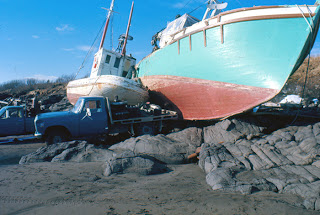Usually in going "behind the art" I deal with some aspect of painting water, reflections, how light behaves on water. But today I will use this painting to illustrate effects of light and shade, since we have a strong sense of bright, overhead light, with equally strong shadows.If we look at the man holding the harpoon, notice how much contrast there is under the shade of the bill of his cap. Making this shade very dark gives the suggestion of how bright the overhead light is. Furthermore, having good light and shade contrast helps to define the harpoon better.
I would especially draw attention to the interesting treatment of light at the tops of the sails. First, we have the larger mainsail brightly reflecting the strong, overhead light. That makes it contrast with the dark cloud behind it. Then just in front of it we have the smaller foresail, which is not reflecting direct bright light, and contrasts with the bright mainsail. And, of course, the lookout at the mast head contrasts with the bright sail behind him. This part of the painting in particular shows how you can use light and shade to bring out features you are depicting and also to create a sense of depth to your subject.


























